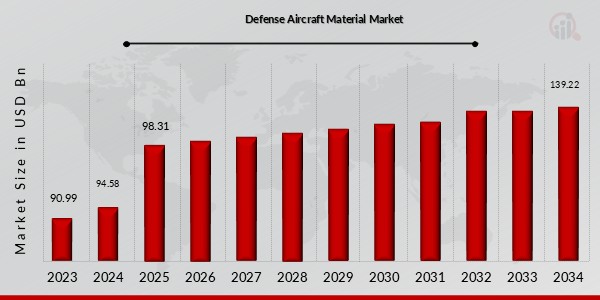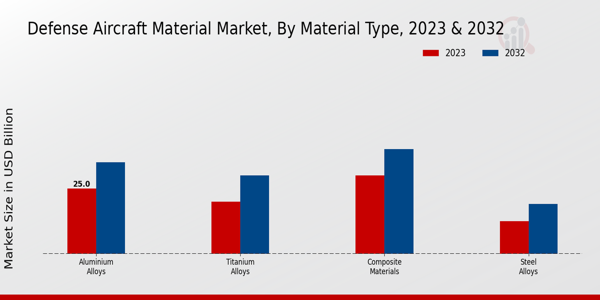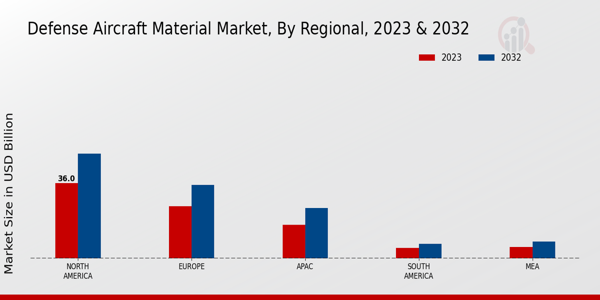Defense Aircraft Material Market Overview
The Defense Aircraft Material Market Size was estimated at 94.58 (USD Billion) in 2024. The Defense Aircraft Material Market is expected to grow from 98.31 (USD Billion) in 2025 to 139.22 (USD Billion) by 2034. The Defense Aircraft Material Market CAGR (growth rate) is expected to be around 3.90% during the forecast period (2025 - 2034).

Source Primary Research, Secondary Research, MRFR Database and Analyst Review
Key Defense Aircraft Material Market Trends Highlighted
Rising geopolitical tensions and increased defense spending are primary drivers behind the growth of the defense aircraft material market. Nations worldwide are investing heavily in modernizing their military capabilities, leading to a higher demand for advanced materials used in defense aircraft.
The need for lightweight and durable materials that enhance fuel efficiency and improve overall aircraft performance further boosts market momentum. Additionally, ongoing technological advancements in composite materials and surface treatments play a crucial role in elevating the standards of defense aircraft, creating a need for continuous innovation.
The market presents significant opportunities, particularly in the development of environmentally sustainable materials and advanced manufacturing processes. Companies can explore collaborations with research institutions to innovate materials that meet eco-friendly criteria while maintaining performance standards.
There is also potential for expanding into emerging markets, where defense budgets are on the rise. Adapting to digital manufacturing and integrating automation can enhance efficiency and reduce costs, presenting an avenue for companies to capture greater market share.
Recent trends indicate a shift towards the use of composite materials over traditional metals, driven by the quest for lighter, more fuel-efficient aircraft. The incorporation of advanced materials is also changing the design and functionality of defense aircraft.
Moreover, the integration of smart technology within materials, enabling aircraft to monitor their own structural integrity, is gaining traction. Additionally, the focus on cybersecurity within the defense sector has led to increased investment in materials that can support secure and resilient systems.
The growing emphasis on research and development further highlights the dynamic nature of the market, setting the stage for continuous evolution and growth in the defense aircraft materials sector.
Defense Aircraft Material Market Drivers
Increasing Military Expenditure
One of the most significant drivers for the Defense Aircraft Material Market is the increasing military expenditure ly. Governments around the world are recognizing the need to enhance their defense capabilities due to rising geopolitical tensions and the constant threat of terrorism.
This has led to substantial budget allocations for military modernization and procurement of advanced defense aircraft, which in turn boosts the demand for high-strength materials utilized in the manufacturing of these aircraft.
As nations seek to maintain or establish air superiority, they are investing in next-generation aircraft that require innovative materials capable of withstanding extreme conditions and pressures. Such materials are essential for improving performance, durability, and safety in the aerospace sector.
Moreover, the modernization of existing fleets also fuels the requirement for upgraded materials, further contributing to market growth. As military strategies evolve, there is a greater emphasis on developing stealth capabilities, fuel efficiency, and reduced maintenance requirements in defense aircraft.
The integration of advanced materials that possess these attributes is critical, thus fostering a heightened demand within the Defense Aircraft Material Market as nations seek to achieve strategic advantages through enhanced aviation technology.
Technological Advancements in Material Science
The relentless pursuit of innovation in material science plays a crucial role in driving the Defense Aircraft Material Market. Advancements such as the development of composite materials, lightweight alloys, and high-performance polymers allow for significant improvements in aircraft performance.
These innovative materials contribute to weight reduction, which enhances fuel efficiency and payload capacity, leading to greater operational effectiveness.
Additionally, improvements in manufacturing techniques, such as additive manufacturing, enable the creation of complex geometries while minimizing waste, thereby driving down costs. The introduction of materials that can withstand extreme temperatures and pressures ensures that defense aircraft can operate in a wider range of environments, enhancing their versatility and reliability.
As technological breakthroughs continue to emerge, they will likely result in the introduction of new materials, further stimulating market growth within the Defense Aircraft Material Market.
Rising Demand for Unmanned Aerial Vehicles (UAVs)
The increasing demand for unmanned aerial vehicles (UAVs) is significantly impacting the Defense Aircraft Material Market. As military operations increasingly shift towards autonomous systems for surveillance, reconnaissance, and combat missions, the requirement for materials that support the lightweight and high-performance specifications of UAVs is on the rise.
UAVs rely on advanced materials that enable them to sustain longer flight times and withstand challenging conditions while maintaining stealth capabilities.
This shift in defense strategies towards incorporating UAVs not only elevates the demand for specific materials tailored to their needs but also drives research and development efforts in the aviation materials sector. As a result, manufacturers are focusing on innovative solutions that meet the unique demands of UAV technologies, thereby contributing to the overall growth of the market.
Defense Aircraft Material Market Segment Insights
Defense Aircraft Material Market Material Type Insights
The Defense Aircraft Material Market reflects a diverse landscape shaped significantly by its Material Type segmentation, which includes Aluminium Alloys, Titanium Alloys, Composite Materials, and Steel Alloys.
Among the predominant materials, Aluminium Alloys held a majority share with a valuation of 25.0 USD Billion, expected to rise to 35.0 USD Billion by 2032. The lightweight yet strong characteristics of Aluminium Alloys make them pivotal in enhancing fuel efficiency and operational performance for defense aircraft, thereby dominating the material preference for military designers.
Following closely, Composite Materials were significantly valued at 30.0 USD Billion in 2023, anticipated to grow to 40.0 USD Billion by the end of the forecast period. This growth can largely be attributed to their superior strength-to-weight ratios and resistance to corrosion, making them an essential component in advanced aircraft design, thus driving innovation in defense aerospace programs.
Titanium Alloys, valued at 20.0 USD Billion in 2023 and projected to increase to 30.0 USD Billion, offered exceptional strength and heat resistance, particularly in critical applications such as engine components and airframes.
Steel Alloys, while holding a smaller market share valued at 12.54 USD Billion in 2023, expected to reach 19.0 USD Billion by 2032, were still significant due to their cost-effectiveness and structural integrity, which plays an important role in various defense applications.
The trends within the Defense Aircraft Material Market indicate a growing inclination toward advanced materials that enhance aircraft performance.
Factors such as increased defense budgets, technological advancements, and geopolitical tensions are driving growth in this sector, creating further opportunities within the market for innovative material solutions that meet the complex demands of modern aerial warfare.
The insights within this material-type segmentation serve to emphasize the critical role each material plays in maintaining operational effectiveness and advancing technological capabilities within the defense industry.

Source Primary Research, Secondary Research, MRFR Database and Analyst Review
Defense Aircraft Material Market Application Insights
The Defense Aircraft Material Market reflects a structured segmentation across various applications critical to military aerospace. Notably, the demand for materials is prevalent in airframes, engines, control surfaces, and landing gear, each playing a crucial role in aircraft performance and safety.
Airframes are fundamental as they provide structural integrity, while engines necessitate advanced materials that withstand high temperatures and pressures, indicating their significant role in market dynamics.
Control surfaces, which facilitate maneuverability, and landing gears, ensuring safe landings, also dominate the market, showcasing their importance in aircraft design and functionality. The market trend is characterized by an increasing emphasis on lightweight and durable materials, driven by the need for improved fuel efficiency and operational effectiveness in defense aircraft.
However, challenges such as material costs and stringent regulations impact the industry's growth. Nevertheless, opportunities arise from advancements in composite materials and innovations in manufacturing processes, paving the way for enhanced performance and sustainability in the Defense Aircraft Material Market.
Overall, the market growth reflects the industry's adaptation to evolving technological demands and defense requirements.
Defense Aircraft Material Market Aircraft Type Insights
The Defense Aircraft Material Market has shown a significant focus on the Aircraft Type segment, which includes Fighter Aircraft, Transport Aircraft, Unmanned Aerial Vehicles (UAVs), and Helicopters.
Fighter Aircraft play a crucial role in national defense due to their advanced technologies and capabilities, catering to combat readiness and tactical missions. Thus, they hold a major share in market growth. Transport Aircraft are essential for logistics and troop movement, significantly contributing to efficiency in military operations.
Unmanned Aerial Vehicles are increasingly gaining traction due to their cost-effectiveness and reduced risk to personnel, reflecting a shift towards modern warfare strategies. Helicopters, recognized for their versatility, are instrumental in a wide range of military operations from transport to reconnaissance.
Trends such as the rising demand for lightweight and durable materials, in line with technological advancements, drive growth in this segment. However, challenges like high maintenance costs and regulatory complexities could hinder expansion possibilities.
Overall, the Defense Aircraft Material Market revenue is positioned to grow, underpinned by these critical segments, with changing dynamics emphasizing their importance in military capabilities.
Defense Aircraft Material Market End Use Insights
The Defense Aircraft Material Market is primarily segmented based on End Use, which includes Military, Government, and Civil Aviation sectors.
The military segment holds a significant share of the market, driven by the ongoing modernization of defense fleets and a focus on enhancing operational capabilities. The Government segment also plays an important role, particularly with rising investments in national security and surveillance projects.
Meanwhile, Air transportation, particularly civil aviation, presents substantial growth opportunities due to the increasing need for efficient and reliable aircraft amidst rising air traffic.
The growth in these sectors is propelled by technological advancements, rising geopolitical tensions, and government attempts to bolster defense capabilities, enhancing the Defense Aircraft Material Market revenue through various strategic initiatives and innovations.
Overall, this segmentation underscores the diverse applications and critical nature of materials utilized in different facets of the aerospace industry, emphasizing the extensive scope for innovation and growth in the market, aligning with broader trends in the Defense Aircraft Material Market Statistics.
Defense Aircraft Material Market Regional Insights
The Defense Aircraft Material Market revenue demonstrated significant regional variations in 2023, with North America leading at 36.0 USD Billion, followed by Europe at 25.0 USD Billion. North America's dominance was attributed to its advanced aerospace sector and substantial defense budgets, showcasing a robust demand for materials.
Europe accounted for a significant share due to its strong defense programs and collaborations. The APAC region, valued at 16.0 USD Billion in 2023, reflects a growing interest in defense modernization, making it a vital contributor to market growth.
South America and MEA, holding valuations of 5.0 USD Billion and 5.54 USD Billion, respectively, presented emerging opportunities, although they have a smaller market presence.
The Defense Aircraft, Material Market segmentation, reveals a landscape where established regions like North America and Europe maintain majority holding, driven by high demand for cutting-edge materials, whereas APAC is rapidly catching up.
As a result, these regions play critical roles in shaping market trends and opportunities for future growth. Understanding the Defense Aircraft Material Market statistics and dynamics across these regions is essential for stakeholders aiming to capitalize on potential market shifts and investments.

Source Primary Research, Secondary Research, MRFR Database and Analyst Review
Defense Aircraft Material Market Key Players and Competitive Insights
The Defense Aircraft Material Market is characterized by its dynamic and competitive landscape, driven by emerging technologies, strategic partnerships, and increasing defense budgets from governments around the world.
The market encompasses a variety of materials used in the building of defense aircraft, including advanced composites, metals, and specialized coatings, which are essential for enhancing performance, reducing weight, and improving durability.
As nations face rising security threats and engage in modernization efforts, the demand for innovative materials in military aviation becomes increasingly critical. This competitive environment not only invites established players but also fosters the entry of new companies striving to provide cutting-edge solutions.
The rapid evolution of technology in materials science complements the need for cost-effective products that meet stringent military standards, ultimately shaping the direction of the market.
Elbit Systems has established a strong foothold in the Defense Aircraft Material Market, leveraging its extensive expertise in advanced materials and systems integration to offer high-performance solutions tailored for military aircraft.
The company demonstrates notable strengths in research and development, continuously investing in new technologies that enhance materials resilience and operational capabilities. Elbit Systems benefits from a robust supply chain management system that ensures timely delivery of components, contributing to efficient production processes.
Its strategic alliances with defense contractors and government agencies further solidify its position in the market, enabling collaborative innovations that meet evolving defense needs. The company also emphasizes sustainability, focusing on developing eco-friendly materials that align with environmental standards, thus enhancing its brand value and market appeal.
Kawasaki Heavy Industries plays a pivotal role in the Defense Aircraft Material Market, recognized for its comprehensive approach combining traditional manufacturing practices with advanced technological implementations.
The company excels in the field of metal processing and design, providing exceptional products that meet rigorous military requirements. One of its key strengths lies in its legacy of innovation, drawing on years of expertise in aerospace engineering to develop materials that optimize aircraft performance while ensuring operational reliability.
Kawasaki Heavy Industries has successfully integrated sophisticated research initiatives into its production processes, contributing significantly to advancements in lightweight materials and structural components.
Furthermore, the company's notable reach and strategic partnerships enable it to cater to diverse market demands, positioning it favorably amidst rising competition and shifting geopolitical dynamics.
Key Companies in the Defense Aircraft Material Market Include
- Elbit Systems
- Kawasaki Heavy Industries
- Thales Group
- Boeing
- BAE Systems
- Textron
- L3Harris Technologies
- Raytheon Technologies
- Northrop Grumman
- Leonardo
- Huntington Ingalls Industries
- Lockheed Martin
- Saab
- Airbus
- General Dynamics
Defense Aircraft Material Market Developments
Recent news developments in the Defense Aircraft Material Market highlight a shift toward increasing demand driven by heightened defense spending and modernization initiatives. Companies like Boeing and Lockheed Martin are seeing growth due to their involvement in advanced materials that enhance aircraft performance.
Collaborations between Thales Group and Elbit Systems are aiming at integrating cutting-edge technology into defense systems, further boosting material requirements. Meanwhile, Northrop Grumman and Raytheon Technologies are focusing on sustainable materials innovations to meet future environmental standards.
There have been notable mergers and acquisitions, particularly the acquisition of a technology firm by General Dynamics to enhance its UAV capabilities and strengthen its market position. This acquisition has received positive attention in industry circles, signaling a competitive edge in advanced materials usage for defense applications.
Additionally, Saab and Airbus are investing significantly in research and development to facilitate next-generation military aircraft, which impacts the market valuation positively. These dynamics indicate a robust growth trajectory in the market, stimulating new opportunities for material suppliers and manufacturers within the defense sector.
Defense Aircraft Material Market Segmentation Insights
Defense Aircraft Material Market Material Type Outlook
- Aluminium Alloys
- Titanium Alloys
- Composite Materials
- Steel Alloys
Defense Aircraft Material Market Application Outlook
- Airframes
- Engines
- Control Surfaces
- Landing Gear
Defense Aircraft Material Market Aircraft Type Outlook
- Fighter Aircraft
- Transport Aircraft
- Unmanned Aerial Vehicles
- Helicopters
Defense Aircraft Material Market End Use Outlook
- Military
- Government
- Civil Aviation
Defense Aircraft Material Market Regional Outlook
- North America
- Europe
- South America
- Asia Pacific
- Middle East and Africa
| Report Attribute/Metric |
Details |
| Market Size 2025 |
94.58(USD Billion) |
| Market Size 2024 |
98.31(USD Billion) |
| Market Size 2034 |
139.22(USD Billion) |
| Compound Annual Growth Rate (CAGR) |
3.90% (2025 - 2034) |
| Report Coverage |
Revenue Forecast, Competitive Landscape, Growth Factors, and Trends |
| Base Year |
2024 |
| Market Forecast Period |
2025 - 2034 |
| Historical Data |
2021 - 2024 |
| Market Forecast Units |
USD Billion |
| Key Companies Profiled |
Elbit Systems, Kawasaki Heavy Industries, Thales Group, Boeing, BAE Systems, Textron, L3Harris Technologies, Raytheon Technologies, Northrop Grumman, Leonardo, Huntington Ingalls Industries, Lockheed Martin, Saab, Airbus, General Dynamics |
| Segments Covered |
Material Type, Application, Aircraft Type, End Use, Regional |
| Key Market Opportunities |
Increased defense spending ly, Adoption of advanced composite materials, Growth in unmanned aerial vehicle production, Sustainability trends in material sourcing, Demand for lightweight and durable materials |
| Key Market Dynamics |
Increasing defense budgets, Technological advancements, Regulatory compliance requirements, Sustainability initiatives, Supply chain vulnerabilities |
| Countries Covered |
North America, Europe, APAC, South America, MEA |
Frequently Asked Questions (FAQ) :
The Defense Aircraft Material Market is expected to be valued at 139.22 USD Billion by 2034.
The expected CAGR for the Defense Aircraft Material Market from 2024 to 2034 is 3.90%.
In 2023, North America held the largest market share in the Defense Aircraft Material Market, valued at 36.0 USD Billion.
The market value of Aluminium Alloys in the Defense Aircraft Material Market was 25.0 USD Billion in 2023.
Key players in the Defense Aircraft Material Market include Boeing, Lockheed Martin, and Raytheon Technologies.
The projected market value for Composite Materials in the Defense Aircraft Material Market is 40.0 USD Billion in 2032.
The Defense Aircraft Material Market was valued at 16.0 USD Billion in the APAC region in 2023.
The main materials driving the market include Aluminium Alloys, Titanium Alloys, Composite Materials, and Steel Alloys.
The expected market value for Steel Alloys in the Defense Aircraft Material Market is 19.0 USD Billion by 2032.
Opportunities for the Defense Aircraft Material Market through 2032 include advancements in materials technology and increased defense spending.

















